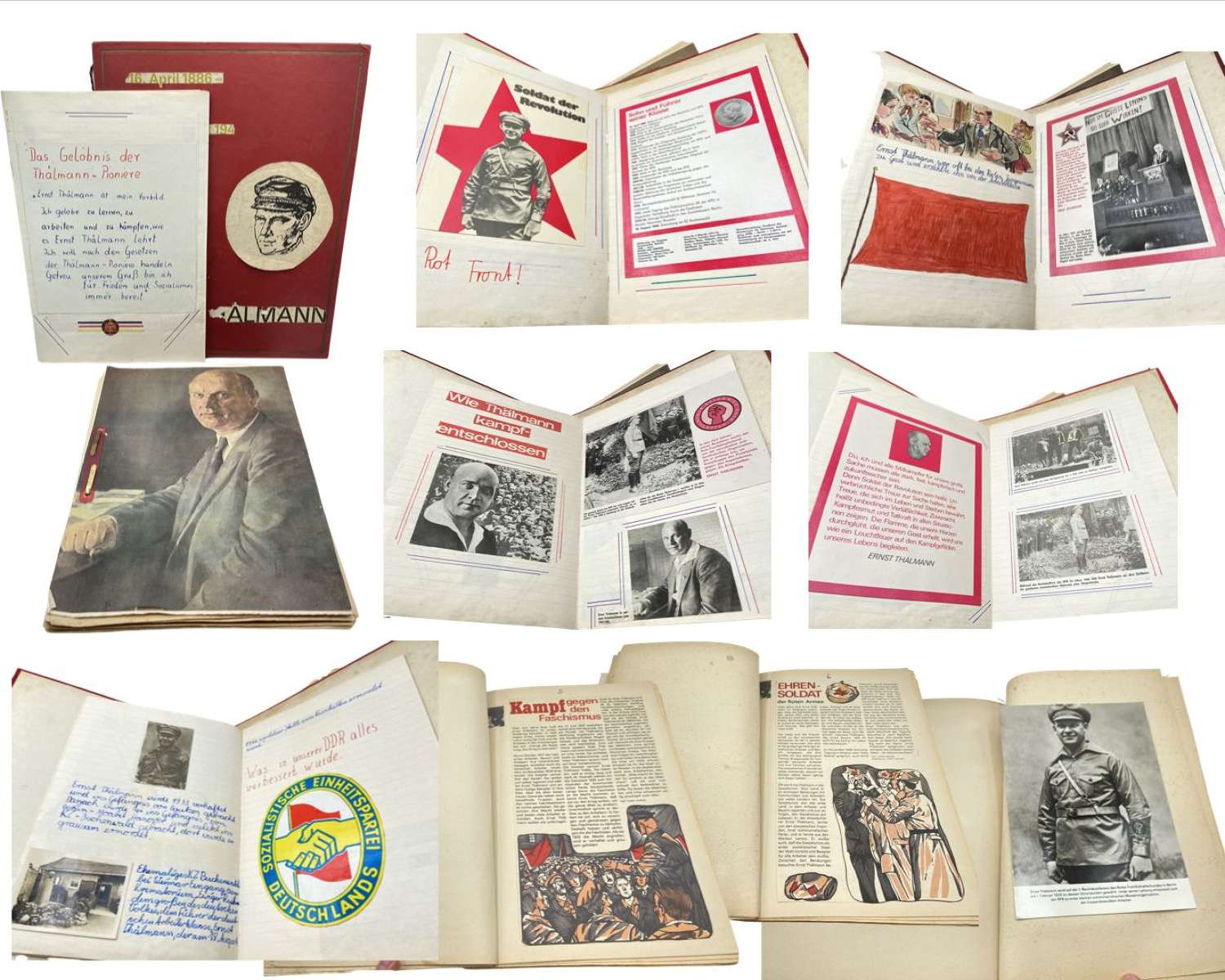
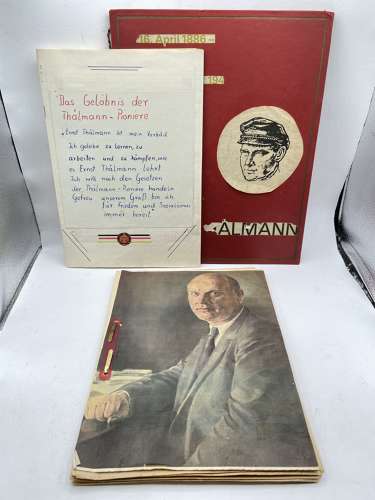
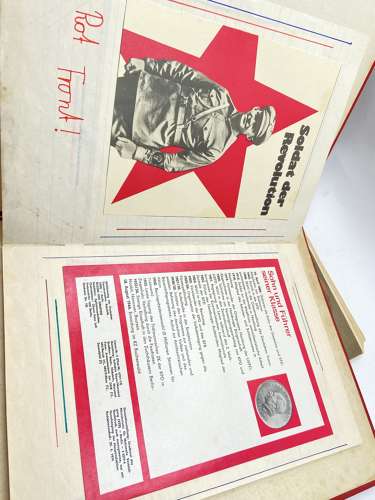
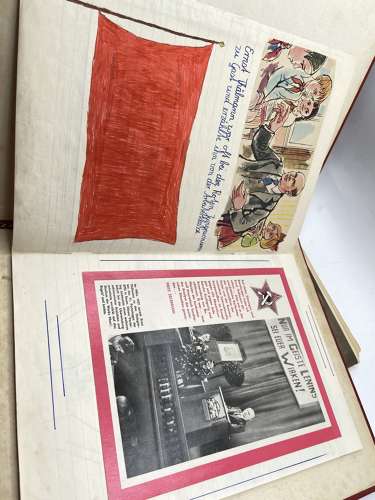
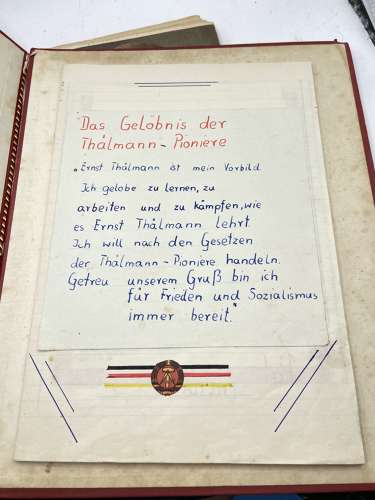
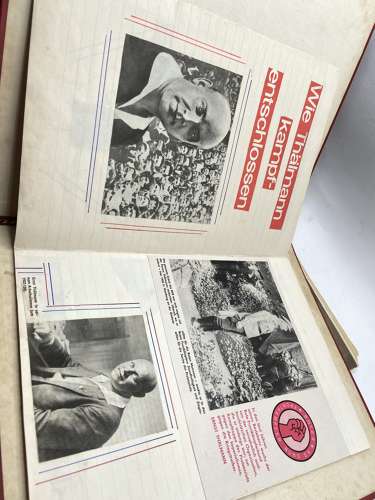
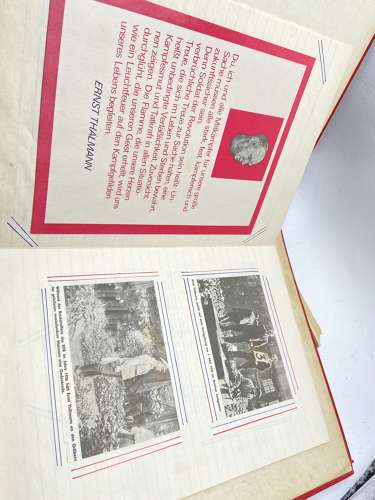

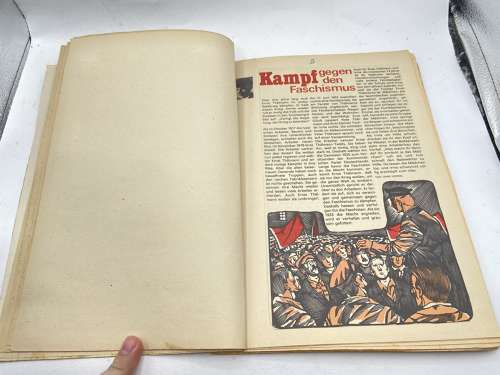
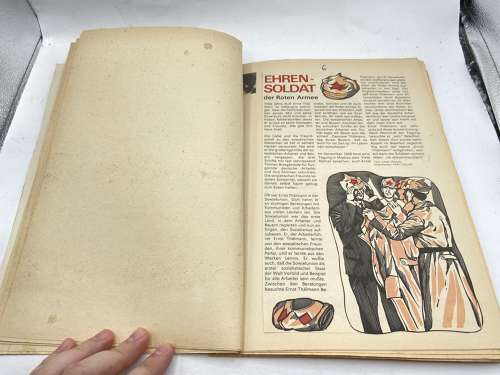
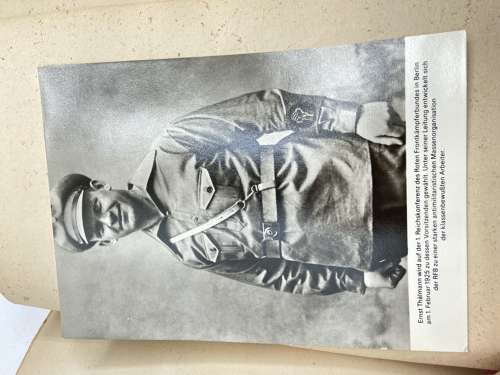
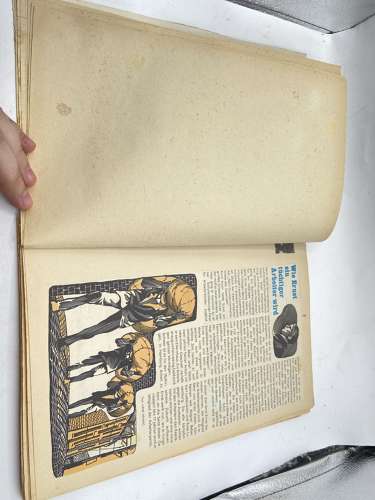
WW2 German Communist KPD Thälmann Pioneers & Ernst Thälmann Scrap Book
Code: 13152
£95.00 Approx $118.31, €110.59, £95
(1 in stock)
(1 in stock)
Qty
For sale is a very rare pair of scrapbooks one that is Pre WW2 1930s German Communist SPD KPD scrapbook dedicated to Ernst Thälmann, and the second scrapbook is a early post war produced by a member of the Thälmann Pioneers. Both scrapbooks are dedicated to the KPD, SPD, Communism & East German Communism, Ernst Thälmann and the Thälmann Pioneers; consisting of drawings, illustrations, hand written texts, newspaper & magazine clippings and original photographs. One of the interesting photographs is At Buchenwald in 1945 to early 1946 of Ernst Thälmann Grave/ memorial with many flowers and a bust of his head taken by the dedicated communist who produced this scrap book.
Inside the post ww2 german communist scrapbook on the first page is a hand written summary stating:
“The pledge of the Thalmann pioneers "Ernst Thälmann is my role model. I vow to learn, to work and to fight, as Ernst Thälmann teaches. I want to act according to the laws of the Thalmann pioneers. True to our greeting, I am always ready for peace and socialism."
These two scrapbooks show how communism took over after ww2 in east Germany and how the youth of Germany were “re-educated” and indoctrinated into the communist regime.
About Ernst Thälmann:
Ernst Johannes Thälmann born 16 April 1886 – died 18 August 1944) was a German communist politician, and leader of the Communist Party of Germany (KPD) from 1925 to 1933. A committed Marxist-Leninist, Thälmann played a major role during the political instability of the Weimar Republic, especially in its final years, when the KPD explicitly sought to overthrow the liberal democracy of the republic. Under his leadership the KPD became intimately associated with the government of the Soviet Union and the policies of Joseph Stalin. The KPD under Thälmann's leadership regarded the Social Democratic Party (SPD) as its main adversary and the party adopted the position that the social democrats were "social-fascists".
Thälmann was also leader of the paramilitary Roter Frontkämpferbund (which was banned as extremist by the governing social democrats in 1929). In 1932 he established Antifaschistische Aktion. He was arrested by the-Gestapo in 1933 and held in solitary confinement for eleven years; for political reasons, Stalin did not seek his release after the Molotov–Ribbentrop Pact with Germany, and Thälmann's party rival Walter Ulbricht ignored requests to plead on his behalf. Thälmann was shot on Adolf-Hitler's personal orders-in-Buchenwald-in-1944.
About the Thälmann Pioneers:
The Free German Youth (Freie Deutsche Jugend--FDJ), were founded after World War II in March 1946, withi the Soviet occupation zone of Germany. Young people between the ages of 14 and 25 were to be indoctrinated as members of a new socialist society. Together with its suborganization for youngsters from 6-14 years of age, the Young Pioneers--later called the Pioneer Organization "Ernst Thalmann," in memory of the chief of the Communist Party (KPD) during the Weimar Republic and was killed by the NAZIs in a concentration camp. The FDJ became an instrument for influencing the coming generations. An important part of its influence was that membership in the FDJ soon determined access to institutions of higher learning, recreation and sports facilities, and ultimately career opportunities.
Influences
The East German Pioneers were influenced by both Scouting and the Hitler Youth, but like the Pioneer movements in other countries, it was a school-based program. Membership and activities were organized around the schools. And unlike both other movements, the Pioneers were a mixed-gender prganization. We note comments like "The pioneer group was based on the Scouts." This is a mistatement. Of course the Scouts were the first important youth movement in many countries, but this was not the case in Germany. The Wandervogel were the first important group. And Baden Powel's Boy Scout movement was only one part of a very diverse youth movement until the-NAZIs made the HJ-the country's single youth movement. In this regard, the Pioneers have much more in common with the HJ-than Scouting. It was similar to the-HJ in that parents did not play a major role in the program. It was another arm of the state in molding young minds independent of parental influence.
Foundation
Communist authorities organized the East German Pioneers after World War II in the Soviet occupation zone. The East German authorities introduced the Free German Youth and the Pioneer Youth (March 1946) less than a year after the War. Communist authorities subsequently renamed their youth movement the Ernst Thälmann Pioneer Organisation in honor of the the former German Communist Party leader killed by the NAZIs-at-the-Buchenwald concentration camp. Another source suggests that the movement was founded a little later (December 13, 1948). This was during the height of the Berlin crisus and resulting Berlin Air Lift.
Membership
Membership in both the Young Pioneers and the Thälmann Pioneers was theoretically voluntary. Membership was not required in the sence of the parents would be arrested or the children taken away. In practice, however, membership was virtually compulsory. As the Pioneers were a school based-program, it was very difficult for the children to avoid memmbership.Membership came to be seen as a matter of course by the children as they were registered at school and would become members unless the children spoke up and refused, thus drawing attention to themselves. It is likely that their teachers and Pioneer leaders would have questioned them about refusing to join. We assume that the schools would report such refusal to the Stasi. And this was something that people living in a police state did not want. The children were registered at school every year to join (December 13). This was the official date the organization was founded in 1948. Children who refused to join thus would have stood out from the great mass of children who joined. Thus almost all children simply followed along with the system and joined. School age children generally do not like to be singled out. Membership in the Pioneers steadily rose after the organization was established and by the 1960s reached an estimated 98 percent of school age children. Now because it was possible to refuse, membership levels of 98 percent ir strong evidence that participation was in no way voluntary. Those who refused to join were primarily motivated by religious purposes. Other children may have refused to join or dropped out because they did not like the program or limits on their free time. We have noted different accounts as to what the implications were of refusing to join. Some report they were unablr to participate in school or other organozed activities. Other dismiss these reports. We suspect that there was some variation in how those who did not join were treated, depebing on the attitudes of individual school authorities. Membership in the Pioneers at least at some level was necessary to join FDJ. And if a young person was not a member of the FDJ, a range of educational opportunities (especially buniversity entance) or occupational areas were closed off. There also could be travel restrictions.
Chronology
There were Communist and Socialist youth movements in Germany before the NAZI-take over, although we do not yet know much abot them. They were supressed after the NAZI-takeover. Many adults associated with the movement were arrested. Communist authorities organized the East German Pioneers after World War II in the Soviet occupation zone. The East German authorities introduced the Free German Youth and the Pioneer Youth in March 1946 less than a year after the War. We do not yet have much information about chronological trends associated with the Young Pioneers in Germany. As far as we know there was no attempt to orgnize a Communist youth movement in West Germany.
Participation
Almost every kid in the German Democratic Republic (DDR) had to participate in Young Pioneers. East Germans who participated in Pioneers report that were a kind of a double-edged sword. Children for all practical purposes had to join the Pioneers (and when older the FDJ) to have any chance of a higher education like college which essentially meant a decent job. Very few few East German children sid not join the Pioneers.
This is a excellent collection of German communist memorabilia from the 1930s to the 1950s. This will be sent via 1st class signed for and dispatched within two working days.
